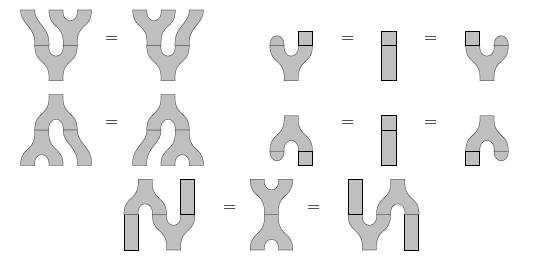Ben-Zvi’s Lectures on Topological Field Theory I
Posted by John Baez
guest post by Orit Davidovich and Alex Hoffnung
Hi! What follows are some notes on the first of David Ben-Zvi’s talks at a workshop on topological field theories, held at Northwestern University in May 2009. We’ll start by sketching the basic ideas, and then we’ll send you over to a PDF file for more details and pretty pictures.
David Ben-Zvi devoted this lecture to -dimensional gauge theory with finite gauge group . The subject of finite group topological field theories started with Dijkgraaf and Witten in their paper Topological Gauge Theories and Group Cohomology. A gauge theory is a quantum field theory in which the fundamental fields are principal -bundles with connection defined over a space-time manifold . In classical field theory we restrict attention to connections satisfying equations of motion (e.g. flat connections). In quantum field theory we study the space of all connections by attaching -linear data to it. In topological field theory we study coarse features of the above depending only on the topology of .
David’s goal for this lecture was to construct an extended -dimensional topological field theory . By ‘extended’ we mean to say that extends down to a point. It assigns ‘values’ to , and -dimensional manifolds. In what follows the path integral is used as a guiding principle.
Another approach to this construction would be the Cobordism Hypothesis which was first stated by Baez and Dolan in their paper on Higher-dimensional Algebra and Topological Quantum Field Theory. Lurie has announced a proof of a very general form of the Cobordism Hypothesis, which was the subject of his lectures at Northwestern, and which we will use in the later lectures. A sketch of the proof can be found in his paper On the Classification of Topological Field Theories. This would be done by showing is a fully dualizable object in a particular -category. This would imply the existence of an extended -dimensional TFT with , and allow us to compute its value for any manifold of dimension less or equal to . This approach can be viewed as a ‘generators and relations’ type construction, while ours can be viewed as an a priori construction.
Continue reading about lecture 1 here.


Re: Ben-Zvi’s Lectures on Topological Field Theory I
Many thanks to Orit and Alex for an amazing job with these notes!! (a marked improvement over the original..)
I’ve put my own badly-handwritten notes for the talks (mine and several others) at NW here . For Jacob’s beautiful lectures (or rather another iteration of them at UT Austin) there are videos and typed-up notes (by Braxton Collier, Parker Lowrey and Michael Williams).